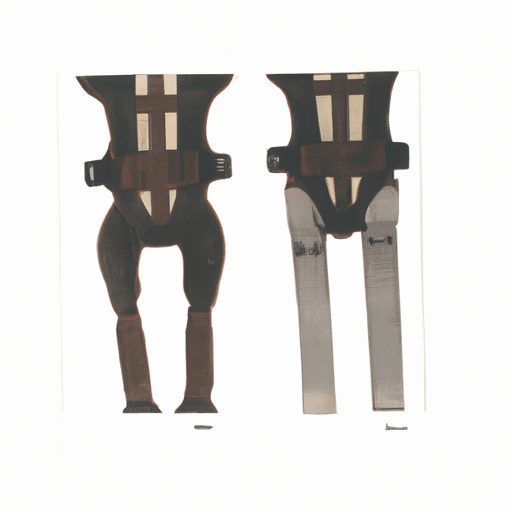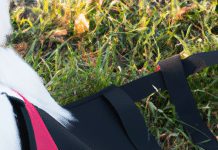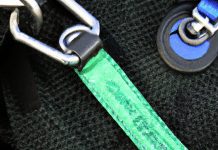Curious about the wonder of a front-clip harness and how it tackles the notorious problem of pulling? Well, we’ve got you covered! In this article, we’ll uncover the mystery behind this ingenious dog-walking accessory, explaining what it is and the magical way it curbs your furry friend’s pulling tendencies. Say goodbye to strained arms and hello to enjoyable walks with your canine companion!
What is a Front-Clip Harness?
A front-clip harness is a type of harness designed specifically for dogs that tend to pull on their leash during walks. Unlike traditional harnesses or collars, which attach at the back of the dog, a front-clip harness has the attachment point on the chest of the dog. This unique placement helps to reduce pulling by redirecting the dog’s forward momentum, making it easier for a handler to control and steer their furry friend.
Table of Contents
Definition
A front-clip harness can be defined as a type of dog harness that has the attachment point located on the front part of the chest. This design allows for better control and minimizes pulling behavior during walks.
Structure and Design
Front-clip harnesses typically consist of adjustable straps that wrap around the dog’s chest and behind the front legs. They also have a D-ring located on the chest portion of the harness, where the leash can be attached. The harness is usually made from durable materials such as nylon or polyester and is designed to distribute the pulling force evenly across the dog’s body.
Advantages of a Front-Clip Harness
Front-clip harnesses offer several advantages over traditional back-clip harnesses and collars. By understanding these benefits, dog owners can make an informed decision about whether a front-clip harness is the right choice for their furry companion.
Reduces Pulling
One of the primary advantages of a front-clip harness is its ability to reduce pulling during walks. When the leash is attached to the chest of the dog, any pulling force exerted by the dog is redirected towards the side instead of forward. This change in direction makes it physically more difficult for the dog to continue pulling and helps to discourage and minimize this undesirable behavior.
Improved Control and Steering
With a front-clip harness, the handler has better control and steering of the dog. As the leash is attached to the chest, the handler can guide the dog’s movement by gently applying pressure to the side instead of the back. This gives the handler the ability to redirect the dog’s attention and adjust their course, making walks more enjoyable and less strenuous for both the dog and the handler.
Prevents Choking and Neck Injuries
Unlike traditional collars that put pressure on the dog’s neck and throat, a front-clip harness distributes the force of pulling across the dog’s body. This helps to prevent choking and reduces the risk of neck injuries, especially for dogs with sensitive throats or brachycephalic breeds with shortened airways. By eliminating strain on the neck, a front-clip harness provides a safer and more comfortable walking experience for the dog.
How Does a Front-Clip Harness Reduce Pulling?
The unique design and placement of a front-clip harness contribute to its effectiveness in reducing pulling behavior. Understanding the mechanisms behind this reduction can help dog owners appreciate the benefits of using a front-clip harness.
Change in Direction
When a dog wearing a front-clip harness pulls forward, the force is redirected to the side instead of being focused straight ahead. This change in direction causes the dog to lose some of its forward momentum, making it more difficult for them to continue pulling. By disrupting the dog’s natural pulling tendency, the front-clip harness encourages them to walk more calmly and reduces their inclination to tug on the leash.
Loss of Balance
The front-clip harness also affects a dog’s balance when they pull. When the leash is attached to the chest, the dog’s center of gravity is shifted slightly off-balance when they pull forward. This imbalance can be uncomfortable for the dog and decreases their desire to pull. By creating a physical discomfort when pulling, the front-clip harness helps to discourage the dog from exerting excessive force and encourages them to walk more politely.
Discomfort and Discouragement
In addition to the change in direction and loss of balance, a front-clip harness can also create a minor discomfort for a dog when they pull. As the force from pulling on the leash is distributed across the chest and torso, the dog may experience a slight pressure or gentle tightening sensation. This discomfort is not harmful or painful, but it serves as a reminder to the dog that pulling is not desirable. Over time, the association between pulling and discomfort can lead to a reduced pulling behavior and ultimately a more pleasant walking experience for both the dog and the handler.
Choosing a Front-Clip Harness
When choosing a front-clip harness for your furry companion, there are several factors to consider to ensure a proper fit, durability, and adjustability.
Proper Fit
It is essential to select a front-clip harness that fits your dog comfortably and securely. The harness should have adjustable straps to accommodate different body shapes and sizes. Measure your dog’s chest circumference and consult the sizing guide provided by the manufacturer to choose the appropriate size. A well-fitting harness should allow for easy movement of the dog’s legs, be snug but not too tight, and stay securely in place during walks.
Material and Durability
Consider the material and construction of the harness to ensure its durability and longevity. Look for a harness made from high-quality, sturdy materials such as nylon or polyester webbing. Reinforced stitching, strong hardware, and well-constructed fasteners are also essential for a durable harness that can withstand regular use and maintain its integrity over time.
Adjustability
A front-clip harness should have adjustable straps to ensure a proper and secure fit. Look for a harness with multiple adjustment points, including the chest and belly straps. This allows for a customized fit that can accommodate the dog’s growth or fluctuations in weight. Proper adjustability ensures that the harness stays securely in place without causing discomfort or impeding the dog’s movement.
Training Your Dog to Use a Front-Clip Harness
To effectively use a front-clip harness, it is essential to introduce it gradually to your dog and reinforce positive behavior.
Gradual Introduction
When introducing a front-clip harness to your dog, take it slow and allow them to acclimate to the new sensation. Begin by letting your dog sniff and investigate the harness without putting it on. Once they are comfortable with the harness, gently place it on their chest and reward them with treats and praise. Gradually increase the duration of wearing the harness and associate it with positive experiences such as treats, playtime, and walks. This gradual introduction helps your dog form a positive association with the harness and reduces any potential anxiety or resistance.
Positive Reinforcement
Training your dog to use a front-clip harness involves positive reinforcement methods. Reward your dog with treats and praise when they exhibit desired behaviors, such as walking calmly by your side or responding to gentle leash guidance. Use verbal cues or clicker training to communicate your expectations and reward your dog for complying. Consistently rewarding and reinforcing positive behavior will help your dog understand and appreciate the benefits of using the front-clip harness and encourage them to walk politely.
Consistency and Patience
Training your dog to use a front-clip harness requires consistency and patience. Be consistent in your use of the harness, using it every time you take your dog for a walk. Stay patient and understanding as your dog learns to adapt to the new walking experience. It may take time for your dog to fully adjust to the front-clip harness and for their pulling behavior to diminish. Through consistent and patient training, your dog will eventually learn to walk calmly and enjoy a more comfortable and controlled walking experience.
Common Mistakes to Avoid with a Front-Clip Harness
Avoiding common mistakes can ensure the optimal use and effectiveness of a front-clip harness.
Using the Wrong Size
Using a front-clip harness that is too large or too small can compromise its effectiveness and potentially cause discomfort to your dog. Take accurate measurements of your dog’s chest circumference and consult the sizing guide provided by the manufacturer to select the appropriate size. An ill-fitting harness may slip off or rub against your dog’s skin, leading to discomfort and potential injuries. Regularly check the fit of the harness and make necessary adjustments as your dog grows or changes in weight.
Incorrect Positioning
Proper positioning of the front-clip harness is crucial for its effectiveness. Ensure that the harness sits snugly on your dog’s chest and sits a few inches behind the front legs. If the harness is too far forward or backward, it may not distribute the pulling force effectively, and it may interfere with the dog’s movement. Double-check the positioning of the harness before each walk to ensure optimal performance.
Inadequate Use of Leash
A front-clip harness is most effective when used in conjunction with a proper leash technique. Avoid using a retractable leash with a front-clip harness as it may not provide the necessary control and can lead to further pulling. Opt for a standard leash with a length suitable for maintaining close control of your dog. Hold the leash firmly but without tension, and focus on gentle leash guidance rather than relying on force or jerking the leash abruptly.
Alternatives to a Front-Clip Harness
While a front-clip harness offers numerous benefits, it may not be suitable for every dog. Here are a few alternatives to consider:
Back-Clip Harness
A back-clip harness functions similarly to a front-clip harness but has the attachment point on the back of the dog. This type of harness is easy to put on and may be suitable for dogs that do not pull excessively during walks. However, it may not be as effective in reducing pulling behavior as a front-clip harness.
Head Halters
Head halters are designed to be worn on a dog’s snout and provide more control over the dog’s head and neck. By directly controlling the dog’s head, head halters can reduce pulling behavior effectively. However, some dogs may find head halters uncomfortable or feel restricted when walking with them.
Martingale Collars
Martingale collars are a type of collar that tightens slightly when the dog pulls, preventing them from slipping out of the collar. While not as effective as a front-clip harness in reducing pulling, martingale collars can provide more control over dogs that tend to back out of regular collars.
Conclusion
A front-clip harness is a valuable tool for dog owners looking to reduce pulling and improve control during walks. By redirecting pulling force, providing better steering, and minimizing strain on the dog’s neck, a front-clip harness offers numerous benefits for both the dog and the handler. When choosing a front-clip harness, consider factors such as proper fit, material durability, and adjustability. Gradual introduction, positive reinforcement, and consistency are key in training a dog to use a front-clip harness effectively. By avoiding common mistakes and considering alternative options, dog owners can find the best solution to meet their dog’s walking needs. With a front-clip harness, enjoyable and comfortable walks become a reality, promoting a stronger bond between dogs and their owners.






























